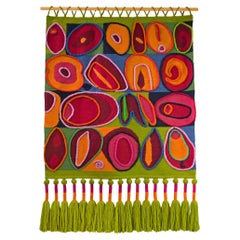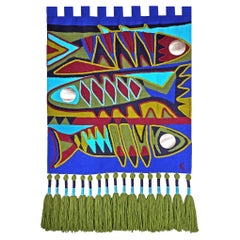Paula Barragan
Recent Sales
2010s Ecuadorean Tapestries
Wool
Early 2000s Ecuadorean Tapestries
Silver
Olga Fisch for sale on 1stDibs
Despite her Hungarian roots, artist Olga Fisch is remembered as the “mother of Ecuadorian folk art” due to her love of Ecuador’s art and culture. Best known for her vibrant rug designs and tapestries, Fisch contributed greatly to promoting Ecuadorian folk art abroad and introducing the country’s traditions and heritage to the world.
Born in Budapest in 1901, Fisch became interested in art at an early age. In her youth, she collected Hungarian folk crafts and was keen on becoming a painter.
In the 1920s, Fisch studied realist painting at an art school in Düsseldorf, Germany. There, she met her first husband, the sculptor Jupp Rübsam, and the couple moved to Vienna, Austria, where she worked as a ceramics designer. Following their divorce, Fisch grew unsettled by the burgeoning anti-Semitism in pre-World War II Germany. After she married for a second time, Fisch and her husband traveled to Morocco, Eritrea, Italy and the United States before receiving asylum status in Ecuador in 1939.
Settling in Quito, Fisch became enamored with traditional Ecuadorian folk art and returned to her childhood hobby of collecting crafts — everything from pottery and hand-carved wood sculptures to colorful textiles. Fisch’s sizable collection prompted her to open a gallery, called Folklore, in 1942. However, what she considered beautiful art was regarded by others as crude.
“When I first started collecting the local Indian art and then opened this gallery, people were shocked,” she said in an interview with The Christian Science Monitor. “I remember someone asking, ‘How can you, as a cultured European woman, collect this trash?’” Nevertheless, Fisch’s collection soon garnered international attention and acclaim.
In the 1940s, Fisch began designing folk art-inspired rugs, hand-woven by indigenous Ecuadorian weavers. One rug caught the eye of acclaimed writer Lincoln Kirstein, then curator of New York’s Museum of Modern Art; he commissioned her to create a rug for the museum’s collection. Over the years, Fisch also made rugs for the United Nations Headquarters and the Metropolitan Opera.
Fisch returned to Hungary in 1987 to visit family members who had survived the Nazi regime. She later came back to Quito, where she died in 1990.
Today, Fisch’s legacy lives on through the Olga Fisch Folklore brand, store and museum, which still operates in Quito. Her works are in the collections of the Museum of Modern Art in New York and the Textile Museum in Washington, DC.
On 1stDibs, discover a range of vintage Olga Fisch rugs and other art.
Finding the Right Tapestry for You
Whether you hang them behind your bed as a dazzling alternative to a headboard or over the sofa as a large-scale focal point in the living room, vintage tapestries can introduce an array of textures and colors to any space in your home.
Woven wall hangings haven’t consistently enjoyed the popularity or earned the highbrow status that other types of wall decorations have over the years, at least not since the 1970s, which was somewhat of a heyday for tapestries. Today, however, these tactile works of art are seeing a renaissance, as modern weavers are forging new paths in the medium while the demand for antique and vintage tapestries continues to grow.
“We are drawn to texture in environments, and we see tapestries as a subtle layer of soft ornament,” says Lauren Larson of the New York design duo Material Lust. Indeed, and a lot of opportunity comes along when decorating with this distinctive brand of soft ornament.
Think of wall hangings as paintings created by hand with fabric instead of oil or watercolors. If you’re not simply securing your treasure to a wall with nails, pushpins or Velcro, tapestries can be stretched over a frame, used to create a canopy in a cozy living-room corner, hung from a rod or placed inside a shadowbox. And because this kind of textile art is hundreds of years old, options abound with respect to subjects and designs.
For richly detailed depictions of landscapes and garden scenes, look to antique Chinese tapestries and Japanese tapestries. Aubusson tapestries are ornate wall hangings manufactured in central France that are also characterized by romantic portrayals of nature. For weavers of mid-century modern tapestries, as well as those working in textile arts today, the styles and subject matter are too numerous to mention, with artists exploring experimental shapes, bold colors and provocative abstract designs.
Antique, new and vintage tapestries can make a room feel warm and welcoming — find yours on 1stDibs now.

